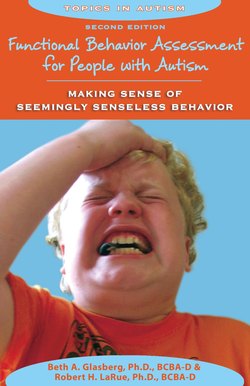Читать книгу Functional Behavior Assessment for People with Autism - Beth Glasberg - Страница 11
На сайте Литреса книга снята с продажи.
Difficulties with Communication Skills
ОглавлениеFirst of all, individuals with autism spectrum disorders often have impairments in communication. Consider Anthony, described in the Introduction. Recall that Anthony was nonvocal. Also recall that his family distracted him from head banging with a special box of beads. In order to keep the beads exciting for Anthony, his family had made the beads off-limits for him at other times. Therefore, Anthony was repeatedly exposed to the following sequence:
1. I have no beads.
2. I bang my head.
3. I get beads.
Anthony’s head banging brings beads into his environment. Since Anthony lacks the communication skills to ask for the beads, he may have learned that banging his head is the best way for him to communicate a request for them. Even if he could request them some other way, they are off limits to him unless he is banging his head.
In a similar scenario, a colleague worked with one nonverbal student who engaged in aggressive behaviors so severe that numerous staff who worked with him had required medical attention for problems as serious as a broken nose. For safety reasons, each time he became aggressive, he was restrained in a cushiony restraint on a soft mat. A functional behavior assessment revealed that his aggressive behaviors were actually his way of requesting access to this restraint. To reduce his aggression, he was given a picture card that he could use to request the restraint. Once he mastered this communication, his aggressive behaviors virtually disappeared.
This is not to say that individuals with ASDs who can speak or sign are immune from exhibiting problem behaviors. Some people can communicate but doing so is so challenging that a problem behavior is simpler. For example, a child with communicative challenges who would like a break from her class work faces two options: 1) Identify a cue from the teacher that it is okay to raise your hand, raise your hand, wait to be called on, formulate a sentence requesting a break, and wait to see whether the teacher says yes or no; or 2) Bang the materials on your desk loudly and get sent immediately to time-out. The latter behavior seems much more efficient for the child.
